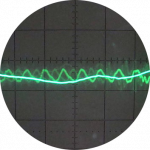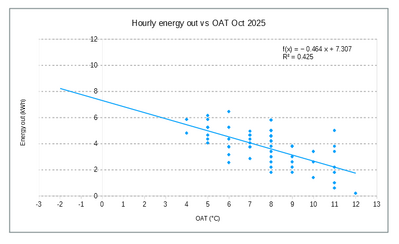@cathoderay I've attached a sample of the data I have (I've just put a few days in for now to check things). For some reason, I can't get the data to produce an accurate scatter. First one I did was fine but when I added 2 more days data the scatter didn't work (I've never had that happen before so I'm confused). The ASHP load is after taking out average hourly load without heating and adjustments for spikes (due to DHW and cooking). I have made COP assumptions according to different OATs.
Let me know if you think I'm on the right lines.
Regards
Yes - I am fully on board with the buffer tank v. volumiser argument and the single ASHP v cascade.
Posted by: @pash44pumpLet me know if you think I'm on the right lines.
I think you are. Here is my plot of your energy out vs OAT:
Despite the small data set, the limited OAT range, the various assumptions made which may or may not be correct, and the low R squared value, my Mk 1 human eyeball can see a trend, and sure enough the trend line when added follows that trend. Note that the trend line for energy out is linear, because (minor influences put aside) heat loss is directly proportional to OAT. This chart on the face of it makes sense.
I did note the IAT is always 21 degrees. That seems remarkably stable. That would make me double check the data is for real.
I then extended the trend line backwards. This is extrapolation, and strictly speaking extrapolation always has a question mark over it (how do we known something extraordinary doesn't happen at say zero degrees?), but with that caveat, and our belief that the relationship is linear (and of course observations of other similar plots with more data), I think the extrapolation is not unreasonable, and we can can conclude, on the basis of this limited data set, that your heat loss at a design OAT of -2°C is around 8kW.
You do of course need more data, three days of relatively mild weather is not enough, but already I think you have something to take to your installer and say hang on a second, what about this?
Midea 14kW (for now...) ASHP heating both building and DHW
@pash44pump Hopefully @cathoderay has demonstrated the value of measured data! Its good to look at everything together though, picking the result that happens to correspond with preference isn't good science! So far as I am aware you have:
- Oil consumption: 3000l (your stated average) = 30MWh. This corresponds, almost certainly, to a loss between 10kW and 15kW. The truth is that 15kW would be a very conservative estimate on this basis and 10kW is likely to be nearer the mark.
- Your plot above: Currently indicating 8kW but too little data particularly at low temps to be that certain. Is there any way you can get a handle on energy out to house without making assumptions about COP?
- Your heat loss surveys: Here is what you said about those:
Posted by: @pash44pumpAs you know, there was also a new Heat Loss Estimate at their expense as my calcs (thanks to the Freedom Heat Pumps model that @cathoderay shared, came out with 12.9kW). Today, I got a call from the installer as I chased the new HLE up and lo and behold. The new HLE shows a requirement of 14kW and I have a 12kW Midea. Apology issued - I do believe them when they tell me this hasn't happened before but they have agreed to redo everything from scratch with probably a 17kW Grant ASHP or 2x10kW ASHPs.
What ACH was your heat loss calculation based on and were there any fabric elements where you had to guess U values. These are the most likely 'errors'.
Ideally you want to reconcile all three (within their margins of error and correcting for known 'issues') over the next weeks to give a high confidence. This should be possible if all the data is put on the table.
The evidence to rule out a cascade is growing!
4kW peak of solar PV since 2011; EV and a 1930s house which has been partially renovated to improve its efficiency. 7kW Vaillant heat pump.
@jamespa and @cathoderay thanks very much.
As always your comments are very valid. In terms of IAT, it has been remarkably stable but for the purpose of first cut test, I did not upload the datalogger data for those days. It has been between 19.9 and 21C so I can tweak that. I agree that this is a tiny dataset but I wanted to check that what I was doing made sense before I hauled the rest of the data out (which is not very time efficient). The IAT is taken from the lowest temperature room (lounge) which is huge volume and has 2 unheated rooms backing on to it (see below)
I will now go ahead and do more. I really wish I could get energy out data but I have no idea where I can get that from with my current set-up. All I can get is energy in and then adjust out normal usage (non-heating) and assume COP.
In terms of HLE I actually asked assumption questions over the weekend and the main issues relative to my own calculations are that ACH was put in at 1.0 for all rooms except bathrooms and kitchen at 1.5, floor insulation was assumed to be zero whereas building regs I believe in 2006 specified minimum 50mm. This is therefore a worst-case scenario on floor insulation.
Some other points of interest, main bed en-suite has poor performance due to undersized UFH and lack of insulation (I think they ran out!) basically just bare brick, void and plasterboard. This will be uprated when we have en-suite changed to 100mm celotex and I have concluded that adding a radiator would be the most efficient thing to do to supplement the UFH. We also have an upstairs room and a downstairs shower room that have no emitters. First has calculated heat loss of 1100W and second of 350W. I plan to put rads in both of those and that should help a lot and allow me to run lower flow temps (at greater efficiency). The HLE is assuming flow temperature of 50C at -2C and I certainly hope I can run at 45C max (especially after improvements).
@cathoderay - I'm intrigued as to how you got the scatter plot to work as when I did it in excel it was returning incorrect values even though I was using the same data (all numeric, no blanks etc)? Did you use excel and make any adjustments?
Regards
@pash44pump - there may be other ways you can improve things apart from using actual data for the IAT. The IAT and OAT will be spot readings, where as the energy is energy over the preceding hour, it might be worth trying quasi-means for the temperatures (average of current reading and immediate past reading). But the real improvements will come from (a) more data and (b) directly reading not estimating energy out. If I have read the right previous post, you have a 16Kw Midea MHC-V12W/D2N8-B heat pump. The wired controller does have energy out inside it, but you need to have a way of recording it automatically, taking hourly readings for months on end is clearly not an option. The three main ways I know of that can record the data are (1) make use of the Midea app (which I think only records hourly lifetime total energy out, in integers, so there are short term errors), and I can't remember how you actually get the data out, if you even can (2) Home Assistant and one of its 'integrations' (which 'sniff' the Midea app wireless data) and (3) getting the data over modbus, which is what I do. Can you make use of any of those?
Posted by: @pash44pumpI'm intrigued as to how you got the scatter plot to work as when I did it in excel it was returning incorrect values even though I was using the same data (all numeric, no blanks etc)? Did you use excel and make any adjustments?
I used LibreOffice Calc, and just selected the data and charted it, no prior manipulation. You are right, Excel can be fussy about blanks and non-numeric data, and it seems as though you have checked those things, but even so I would double check, one rogue cell can cause all sorts of problems.
Midea 14kW (for now...) ASHP heating both building and DHW
@batalto Looks fine to me too, then I noticed the date! these old posts crop up too often then if you reply often get a message saying it was sorted say years ago!
@cathoderay unfortunately, I don't have modbus or HA. I connected to the Midea Home App and it gives me sweet FA apart from telling me my tank temperature and that WC is on! No energy stats. I've written to support but I'm not holding my breath.
Something I was thinking about this morning (which I indirectly alluded to previously). The HLE comes out (for better or worse) at 14kW. One thing though, some of our rooms have no emitters at all and one has UFH that is vastly underpowered (not enough coverage). The estimated heat loss for those rooms is over 3 Kw. My plan is to add radiators in those rooms. So effectively that means that the current estimated HLoss from the 3 day experiment shouldn't be compared to the 14 Kw number because the heat pump is not heating them at the moment apart from some transference from other rooms. If I'm not mistaken, that means the estimated HLE is more like 11 kW for the rooms that are being heated, which is not so far off. The HLE is at 50C flow and -2C external. My current WC is 27C at 15C OAT and 45C at 0C. Actual OAT is usually 2C lower than the controller measured temperature. So, even if my heat loss is 8kW (tiny sample I know) or even 10kW (adjusting for possible colder weather issues), it will certainly be larger when you add in the rooms with nearly 3kW of estimated loss. So probably over my current 12 kW ASHP's max output, which you have previously explained is closer to 10kW in colder weather conditions
Is my thinking here sound about what our measurement should be based on?
We then come back to the proposed 17 kW heat pump. According to Grant's data (I know - pinch of salt), the max output at 50C and OAT of 0C is 15.5 Kw and at 45C it's 15.9Kw. If we take 20% off to add realism, that would suggest more like 12-13kW. That does suggest that 17kW is too large but not by a huge amount.
So looking at issues around an oversized heat pump in milder weather, if I do the following things, won't that actually mean that I can run the system efficiently?
Let's say my loss is 12kW (I will try to measure it more accurately) and I have the 17kW with a 30l volumiser. That gives me 200 litres approx system volume (I calculated this yesterday). The volumiser adds 0.2kWh (at delta t =5k) to the thermal mass of the circuit so the on-cycles last longer. Good. According to Grant's manual that would make a min run time of 4 mins (a bit less than their recommended 5 mins) but with UFH mixing, WC and gradual load changes, the cycle should get closer to the 5 mins so short-cycling risk is managed and maybe the SCOP penalty is not so bad.
Can I raise the compressor anti-short cycle time to say 6 minutes? Would widening the flow temp hysteresis by 1-2C help as well?
Does this make sense?
My feeling at the moment is that the installer is doing too much guessing at the expense of my long-term system efficiency. They are planning a December install but I'm thinking that we should do it in 2 stages. Get the additional emitters in, measure the performance and heat loss and then size the new heat pump. I can also look at adding monitoring capabilities in the interim (that would work now and in the future).
I want the right system for the next 10 years and more. It took me 4 years to get them to sit up so a few more months wouldn't hurt.
Thoughts?
@pash44pump So are you changing from a Midea HP to a Grant HP? What size is the property?
Posted by: @pash44pumphe estimated heat loss for those rooms is over 3 Kw. My plan is to add radiators in those rooms. So effectively that means that the current estimated HLoss from the 3 day experiment shouldn't be compared to the 14 Kw number because the heat pump is not heating them at the moment apart from some transference from other rooms.
Unless the rooms are very cold they are still being heated somehow (ie by heat transference) so I wouldnt make this extrapolation however....
Posted by: @pash44pumpMy feeling at the moment is that the installer is doing too much guessing at the expense of my long-term system efficiency. They are planning a December install but I'm thinking that we should do it in 2 stages. Get the additional emitters in, measure the performance and heat loss and then size the new heat pump. I can also look at adding monitoring capabilities in the interim (that would work now and in the future).
Absolutely spot on IMHO.
4kW peak of solar PV since 2011; EV and a 1930s house which has been partially renovated to improve its efficiency. 7kW Vaillant heat pump.
@dgclimatecontrol I have a Midea heat pump but it has not reached target temps in the coldest periods and the installers have accepted that now and are proposing a Grant 17kW to replace it
Posted by: @pash44pumpI connected to the Midea Home App and it gives me sweet FA apart from telling me my tank temperature and that WC is on! No energy stats.
It is pretty awful, but from what I remember (I no longer have the Midea app) there is are History pages somewhere (maybe start looking top right hand corner of screen?) that do show historic data, but the problem was how to get them out of the app and into use. I never found a way to do that hence moving on to better ways. But if you can find those history pages, and they have energy out, they will provide a useful sanity check on your estimated energy out.
Posted by: @pash44pumpMy feeling at the moment is that the installer is doing too much guessing at the expense of my long-term system efficiency. They are planning a December install but I'm thinking that we should do it in 2 stages. Get the additional emitters in, measure the performance and heat loss and then size the new heat pump. I can also look at adding monitoring capabilities in the interim (that would work now and in the future).
Like @jamespa, I agree, particularly on getting the additional emitters fitted and running - you need to system to be as it will be, to get reliable numbers. I also agree they will make a difference, obvs, but not necessarily as much as their nominal value, for the reasons already given.
Midea 14kW (for now...) ASHP heating both building and DHW
@pash44pump Okay thanks for explaining. Must be a large property, I have 310sq.m and that takes just 10.5kW (I had been quoted two 12kW by a popular rival!) Theres nothing wrong with Midea and they have good support, as does Grant. I wish you well going forwards...
- 26 Forums
- 2,342 Topics
- 53 K Posts
- 373 Online
- 6,000 Members
Join Us!
Worth Watching
Latest Posts
-

RE: Are We Sleepwalking Into Another Race to the Bottom?
…otherwise known as “hive got news for you”. And don’...
By Majordennisbloodnok , 8 hours ago
-
RE: Configuring third party dongle for Ecodan local control
Logically, I'll fall into that category so the natural ...
By Sheriff Fatman , 9 hours ago
-

RE: Controlling Daikin Altherma via P1P2 and Home Assistant
I haven’t got a Daikin but I have been having some fun ...
By Majordennisbloodnok , 9 hours ago
-

RE: Setback savings - fact or fiction?
@robs — thanks again for your detailed comments. Some r...
By cathodeRay , 11 hours ago
-
RE: Free Ecoheat Heat Pump Install
I don't mind thread drift, it's how conversation natura...
By Deltona , 13 hours ago
-

RE: A Smarter Smart Controller from Homely?
@papahuhu I hope you get a swift resolution. Regards, T...
By Toodles , 15 hours ago
-

RE: Poll for Time of Use, tariffs, technology
That’s fine by me too Major, I feel it is a sad reflect...
By Toodles , 16 hours ago
-

Bingo. Sometimes a judiciously placed size 10 bovver bo...
By Majordennisbloodnok , 17 hours ago
-
RE: Mitsubishi Ecodan 11.2kW heat pump with low COP
@ciocoiu-alexandru I can't provide the same level of di...
By Sheriff Fatman , 17 hours ago
-
RE: Octopus Cosy Heat Pump Owners & Discussion Thread
Recently had my follow up with octopus for the vibratio...
By swwils , 18 hours ago
-

The three technical issues I'm considering are: BMS...
By Transparent , 19 hours ago
-
RE: LiFePO4 lithium battery fires and explosions
@transparent Your post may fit better in th...
By Batpred , 20 hours ago
-

RE: British Gas vs Octopus Energy vs Heat Geek vs EDF vs Aira vs OVO vs EON.Next vs Boxt
@jamespawhite, if you could be bothered, you could also...
By Mars , 21 hours ago
-
RE: Commencing on an ASHP Installation Process
I've got a bit of time to draft something today, so the...
By Sheriff Fatman , 2 days ago
-
RE: Help with heat pump sizing
@amin I dont think materially relative to t...
By JamesPa , 2 days ago
-

@majordennisbloodnok I have decided to take the plunge....
By TechnoGeek , 2 days ago
-
RE: Different dT on each radiator?
I cant sorry. Its based on some calculations I did fro...
By JamesPa , 2 days ago
-
RE: Help me keep the faith with my air source heat pump installation
@simonf thats interesting as I’ve noticed my flow and r...
By AdamK , 3 days ago





